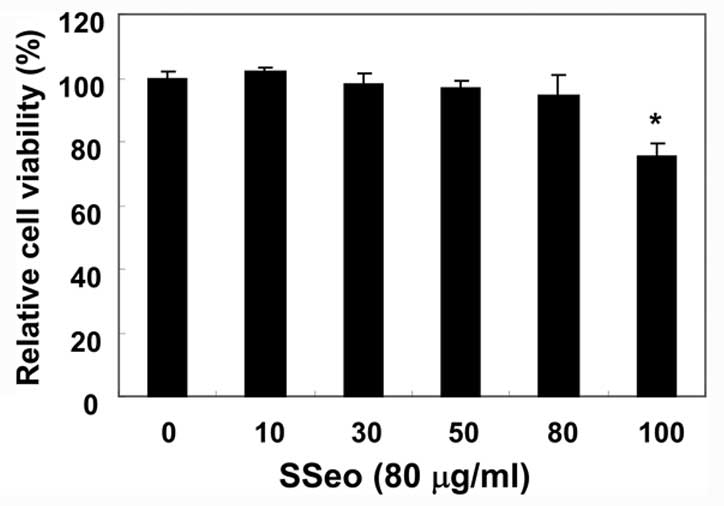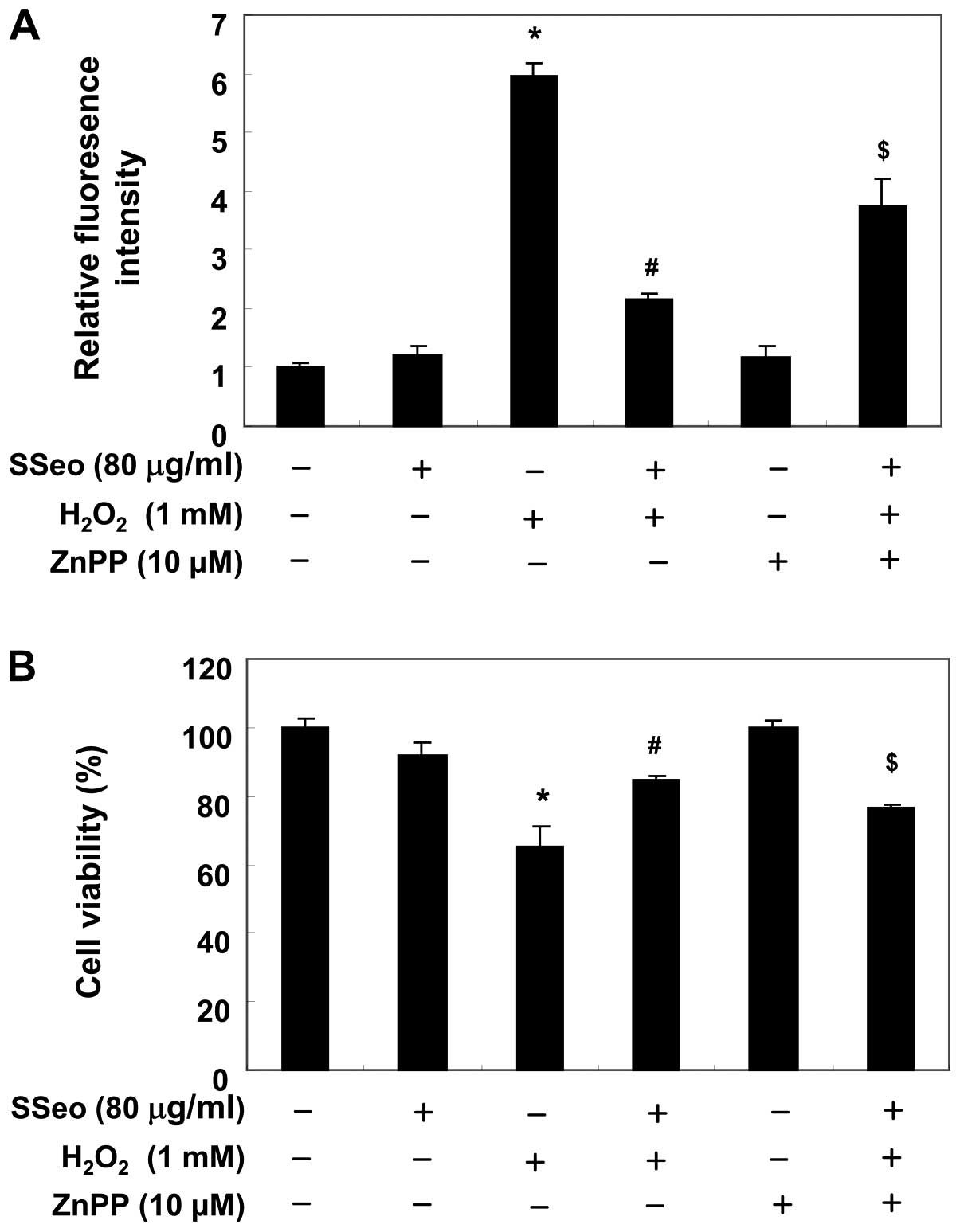|
1
|
Zhang Y, Du Y, Le W, Wang K, Kieffer N and
Zhang J: Redox control of the survival of healthy and diseased
cells. Antioxid Redox Signal. 15:2867–2908. 2011. View Article : Google Scholar : PubMed/NCBI
|
|
2
|
Piantadosi CA: Carbon monoxide, reactive
oxygen signaling, and oxidative stress. Free Radic Biol Med.
45:562–569. 2008. View Article : Google Scholar : PubMed/NCBI
|
|
3
|
Ray PD, Huang BW and Tsuji Y: Reactive
oxygen species (ROS) homeostasis and redox regulation in cellular
signaling. Cell Signal. 24:981–990. 2012. View Article : Google Scholar : PubMed/NCBI
|
|
4
|
Ott M, Gogvadze V, Orrenius S and
Zhivotovsky B: Mitochondria, oxidative stress and cell death.
Apoptosis. 12:913–922. 2007. View Article : Google Scholar : PubMed/NCBI
|
|
5
|
Valko M, Leibfritz D, Moncol J, Cronin MT,
Mazur M and Telser J: Free radicals and antioxidants in normal
physiological functions and human disease. Int J Biochem Cell Biol.
39:44–84. 2007. View Article : Google Scholar
|
|
6
|
Chapple SJ, Siow RC and Mann GE: Crosstalk
between Nrf2 and the proteasome: therapeutic potential of Nrf2
inducers in vascular disease and aging. Int J Biochem Cell Biol.
44:1315–1320. 2012. View Article : Google Scholar : PubMed/NCBI
|
|
7
|
Alam J and Cook JL: Transcriptional
regulation of the heme oxygenase-1 gene via the stress response
element pathway. Curr Pharm Des. 9:2499–2511. 2003. View Article : Google Scholar : PubMed/NCBI
|
|
8
|
Jeong WS, Jun M and Kong AN: Nrf2: a
potential molecular target for cancer che-moprevention by natural
compounds. Antioxid Redox Signal. 8:99–106. 2006. View Article : Google Scholar : PubMed/NCBI
|
|
9
|
Chen XL and Kunsch C: Induction of
cytoprotective genes through Nrf2/antioxidant response element
pathway: a new therapeutic approach for the treatment of
inflammatory diseases. Curr Pharm Des. 10:879–891. 2004. View Article : Google Scholar : PubMed/NCBI
|
|
10
|
Panossian A and Wikman G: Pharmacology of
Schisandra chinensis Bail.: an overview of Russian research and
uses in medicine. J Ethnopharmacol. 118:183–212. 2008. View Article : Google Scholar : PubMed/NCBI
|
|
11
|
Lu Y and Chen DF: Analysis of Schisandra
chinensis and Schisandra sphenanthera. J Chromatogr A.
1216:1980–1990. 2009. View Article : Google Scholar
|
|
12
|
Ma CH, Liu TT, Yang L, Zu YG, Chen X,
Zhang L, Zhang Y and Zhao C: Ionic liquid-based microwave-assisted
extraction of essential oil and biphenyl cyclooctene lignans from
Schisandra chinensis Baill fruits. J Chromatogr A. 1218:8573–8580.
2011. View Article : Google Scholar : PubMed/NCBI
|
|
13
|
Ma CH, Yang L, Zu YG and Liu TT:
Optimization of conditions of solvent-free microwave extraction and
study on antioxidant capacity of essential oil from Schisandra
chinensis (Turcz) Baill. Food Chem. 134:2532–2539. 2012. View Article : Google Scholar
|
|
14
|
Ikeya Y, Taguchi H, Yosioka I and
Kobayashi H: The constituents of Schizandra chinensis Baill. I.
Isolation and structure determination of five new lignans, gomisin
A, B, C, F and G, and the absolute structure of schizandrin. Chem
Pharm Bull (Tokyo). 27:1383–1394. 1979. View Article : Google Scholar
|
|
15
|
Lee YW, Voyksner RD, Pack TW, Cook CE,
Fang QC and Ito Y: Application of countercurrent
chromatography/thermospray mass spectrometry for the identification
of bioactive lignans from plant natural products. Anal Chem.
62:244–248. 1990. View Article : Google Scholar : PubMed/NCBI
|
|
16
|
Opletal L, Sovová H and Bártlová M:
Dibenzo[a,c]cyclooctadiene lignans of the genus Schisandra:
importance, isolation and determination. J Chromatogr B Analyt
Technol Biomed Life Sci. 812:357–371. 2004. View Article : Google Scholar : PubMed/NCBI
|
|
17
|
Wang L, Chen Y, Song Y, Chen Y and Liu X:
GC-MS of volatile components of Schisandra chinensis obtained by
supercritical fluid and conventional extraction. J Sep Sci.
31:3238–3245. 2008. View Article : Google Scholar : PubMed/NCBI
|
|
18
|
Liu CJ, Zhang SQ, Zhang JS, Liang Q and Li
DS: Chemical composition and antioxidant activity of essential oil
from berries of Schisandra chinensis (Turcz) Baill. Nat Prod Res.
26:2199–2203. 2012. View Article : Google Scholar
|
|
19
|
Chen X, Zhang Y, Zu Y and Yang L: Chemical
composition and antioxidant activity of the essential oil of
Schisandra chinensis fruits. Nat Prod Res. 26:842–849. 2012.
View Article : Google Scholar
|
|
20
|
Song L, Ding JY, Tang C and Yin CH:
Compositions and biological activities of essential oils of Kadsura
longepedunculata and Schisandra sphenanthera. Am J Chin Med.
35:353–364. 2007. View Article : Google Scholar : PubMed/NCBI
|
|
21
|
Minaiyan M, Ghannadi AR, Afsharipour M and
Mahzouni P: Effects of extract and essential oil of Rosmarinus
officinalis L. on TNBS-induced colitis in rats. Res Pharm Sci.
6:13–21. 2011.PubMed/NCBI
|
|
22
|
Lee SJ, Hwang SO, Noh EJ, Kim DU, Nam M,
Kim JH, Nam JH and Hoe KL: Transactivation of bad by
vorinostat-induced acetylated p53 enhances doxorubicin-induced
cytotoxicity in cervical cancer cells. Exp Mol Med. 46:e762014.
View Article : Google Scholar : PubMed/NCBI
|
|
23
|
Xie H, Wise SS, Holmes AL, Xu B, Wakeman
TP, Pelsue SC, Singh NP and Wise JP Sr: Carcinogenic lead chromate
induces DNA double-strand breaks in human lung cells. Mutat Res.
586:160–172. 2005. View Article : Google Scholar : PubMed/NCBI
|
|
24
|
Lee DS, Li B, Kim KS, Jeong GS, Kim EC and
Kim YC: Butein protects human dental pulp cells from hydrogen
peroxide-induced oxidative toxicity via Nrf2 pathway-dependent heme
oxygenase-1 expressions. Toxicol In Vitro. 27:874–881. 2013.
View Article : Google Scholar : PubMed/NCBI
|
|
25
|
Hampton MB and Orrenius S: Redox
regulation of apoptotic cell death. Biofactors. 8:1–5. 1998.
View Article : Google Scholar : PubMed/NCBI
|
|
26
|
Chandra J, Samali A and Orrenius S:
Triggering and modulation of apoptosis by oxidative stress. Free
Radic Biol Med. 29:323–333. 2000. View Article : Google Scholar : PubMed/NCBI
|
|
27
|
Nguyen TT, Park HJ, Kim JY, Kim HE, Lee H,
Yoon J and Lee C: Microbial inactivation by cupric ion in
combination with H2O2: role of reactive
oxidants. Environ Sci Technol. 47:13661–13667. 2013. View Article : Google Scholar : PubMed/NCBI
|
|
28
|
Lee EK, Kim JA, Park SJ, Kim JK, Heo K,
Yang KM and Son TG: Low-dose radiation activates Nrf1/2 through
reactive species and the Ca2+/ERK1/2 signaling pathway
in human skin fibroblast cells. BMB Rep. 46:258–263. 2013.
View Article : Google Scholar : PubMed/NCBI
|
















